Choosing the Ideal Gutter Type for Your Home
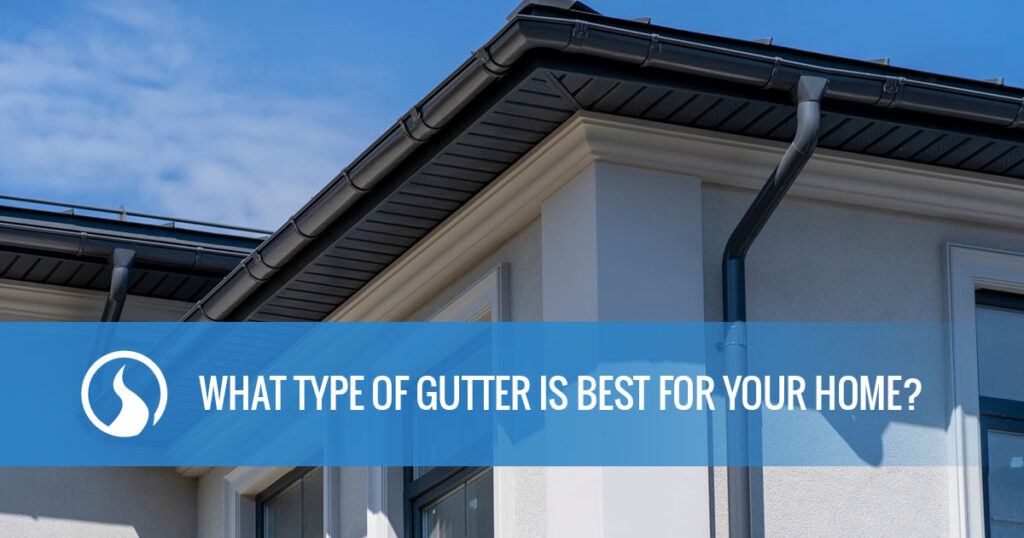
Gutters are integral to your home’s roofing system. While they keep rain from drenching you as you walk in the door, they also direct water and snow away from your siding and foundation. A few inches of rainfall and snow now and then can build up to extensive damage if you don’t have the right gutter system.
So, what’s the best type of gutter for your home? There are many factors to consider, from quality and material to shape and cost. Here, we’ll discuss the gutter types, the best gutter guards for your home and the benefits and drawbacks of each material to help you make a confident purchase.
Signs You Need New Gutters
If your gutters show signs of severe wear, it may be time to hire replacement services. Dangerous water leaks and overflows can significantly damage your home, sometimes before you’re even aware of the problem. New gutters can continue to reduce the risk of water damage to your home, foundation and basement and prevent mold growth.
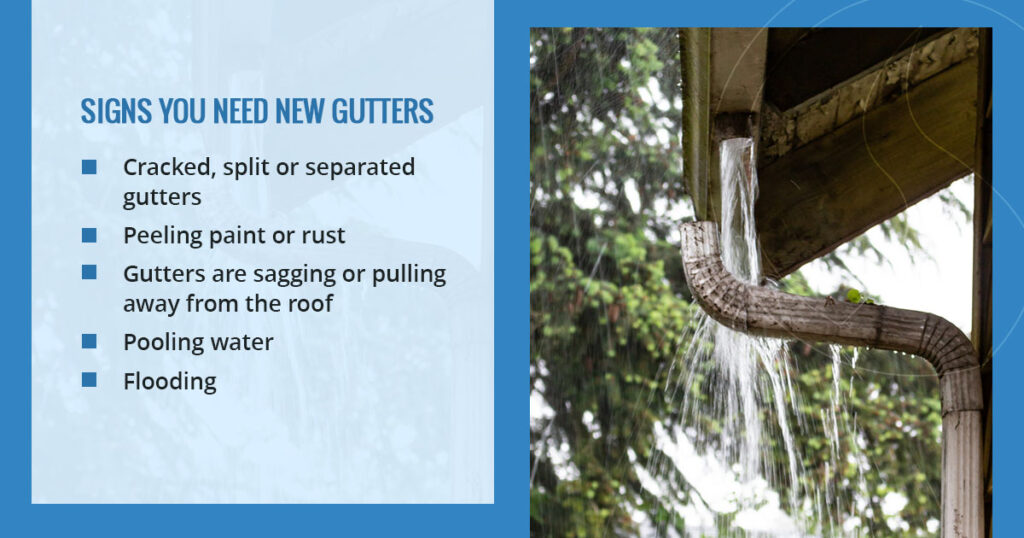
Some signs you need new gutters can include:
- Cracked, split or separated gutters: The seams or joints where sections of your gutters connect are the most delicate parts of any gutter system. If you notice your gutter is pulling away from the joints, it’s likely nearing the end of its life span. Splits or cracks elsewhere along your gutters are another sign they’re wearing out. If you neglect to replace them, they can grow, especially in colder temperatures, as ice seeps in to expand the cracks.
- Peeling paint or rust: Most gutters are coated or painted for weatherproofing. While peeling paint or rust may not seem the most significant concern at first, it indicates that it’s time to replace your gutters. The paint protects against moisture and rainwater, and when it starts to flake, your gutters can begin to rust and get holes, allowing rainwater to seep through.
- Gutters are sagging or pulling away from the roof: Sagging gutters signify the system is too heavy for its original fasteners. Usually, this is because your gutters are too full of water and not draining correctly. It could also mean your gutter fasteners have worn out. In either case, sagging gutters indicate it’s time to replace them.
- Pooling water: If you notice water pooling below your gutters and near your foundation, it means your gutters can’t correctly divert water away from your home. You might notice water spilling over the top of the gutter rather than through the system and into downspouts. You’ll need to replace gutters quickly if you see pooling water. The more water that gathers near your foundation, the greater the risk of flooding.
- Flooding: A key sign it’s time to replace your gutters is water pooling in your basement. Properly functioning gutters direct water away from your foundation. When they no longer work properly, water can spill into your home’s foundation and enter the basement. Old gutters might be the culprit if you notice water entering your basement after a storm or heavy rainfall.
Your gutters are a critical part of your home and roofing system. As they near the end of their life, they can no longer perform and protect your home. If you notice any of the above signs, it might be time to replace your gutters.
Factors to Consider Before Installing New Gutters
Before purchasing new gutters, you’ll want to consider the following factors:
1. Labor Costs
Hiring experts for professional gutter installation is essential before beginning any project. Experts will use the highest quality materials and ensure a proper fitting when installing your gutter system. They can also get the job done faster and safer than someone without experience.
There are a few factors that can affect gutter installation costs, determining how much you pay to hire a roofing team:
- Home size: Gutters on one-story homes are often more affordable to install. Homes that are two stories or higher will likely require additional materials and labor costs.
- Roof layout: Corners can be the more challenging parts of the gutter to install, so you can expect higher chargers for a roof with more than six corners.
- Gutter material: Labor prices are higher for gutter materials that are heavier or more challenging to work with, such as copper and steel.
- Roof access: Roof accessibility and steepness can also affect the costs of your gutter installation, as roofers will often charge more to install gutters with steep roofs or where the eaves are harder to access.
- Gutter type: Many companies produce and install gutters, making this a more affordable option than paying for labor and materials separately.
Fortunately, professional roofing companies, like Coldstream Exteriors, provide free estimates for their services so you can consult with experts to determine the best type of gutter for your home and budget accordingly.
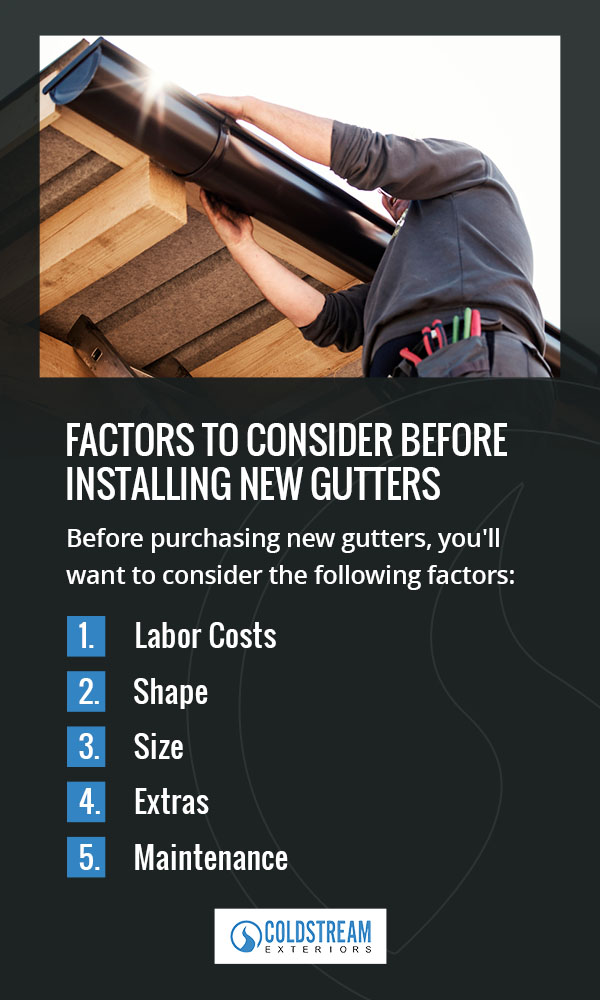
2. Shape
Another factor to consider when selecting gutters for your home is the shape of the system. The most common gutter shapes and their pros and cons include:
- K-style: Of all the types of gutters, K-style gutters are the most utilized in residential homes. They’re named for their cross-section that resembles the letter “K.” The unusual shape allows these gutters to hold more water than other types. It has a flat bottom and outlined face that looks like crown molding and is commonly fitted with rectangular downspouts.
- U-style: Half-round or U-style gutters are also popular, though they’re often less affordable than K-style gutters because they’re not as readily available. The semicircular trough has a curled front lip, making it a natural fit for traditional homes. This gutter shape pairs best with round downspouts, which drain water more efficiently than rectangular ones.
- Fascia gutters: These are custom-built gutters that provide a contemporary look. You’ll need to hire a professional installer to build a system from one piece of aluminum tailored to your home. As a result, fascia gutters can be less affordable than U-style or K-style gutters.
3. Size
It’s also helpful to determine the correct size gutter you’ll need for your property before hiring installation services. The most common gutter size is 5 inches wide, though you might also discover 4- or 6-inch gutters.
If your home requires smaller or larger gutter sizes, you might need to look into custom gutters. Generally, the larger the gutter, the more materials will cost.
4. Extras
Gutter systems require more than just the rain gutters themselves. Your professional roofing company will help you determine the correct hangers and brackets to attach the gutters to your roof, as well as downspouts and elbows to direct water away from your home’s foundation.
The following is a list of common materials you’ll want to account for when installing new gutters on your property:
- Downspouts: Professional roofers will install downspouts to drain water from the gutters. The downpour is the gutter section that extends vertically down the side of your home, directing water from the roof and into the ground or collection vessel. The downspout is a crucial component of your gutter system, and the cost will vary depending on the length of gutter your home requires.
- Downspout elbow: The elbow refers to the angled piece at the bottom of the downspout. It resembles an elbow and diverts water even further from your home’s foundation to prevent flooding. Elbows are necessary for linking gutters to the downpipe on the side of your home.
- End caps: End caps are small pieces that attach to the end of each gutter to seal it off. You might require end caps at the end of each gutter run, and they can cost anywhere from $1.50 to $4 each.
- Hangers and brackets: Gutter systems require hangers and brackets to attach the gutters to your roof every 2 to 3 feet. These strips of metal support your gutter at the bottom to prevent sagging. They’re generally an unnoticeable component of your gutter system unless you’re specifically looking for them.
- Mitered corner: This piece fits on your roof’s corner where your panels meet to add extra protection from gutter failure.
- Gutter guards: You can also choose from different gutter guards to prevent debris from entering your gutters. These are available in micro mesh, brush, reverse curve, foam and screen options. Screen guards are most common, featuring wire or plastic grids to block leaves from entering the gutter trough.
- Heat tape: You might also invest in heat tape for the winter months, which can prevent ice dams from forming over the eaves and gutters to reduce damage to your roof.
Once again, gutter pricing varies based on the material you choose. However, investing in the right add-ons can help improve your gutter’s life span so you get the most out of your new system or replacement.
5. Maintenance
No matter the type of gutter you choose for your home, remember that all gutters require periodic cleaning. You’ll want to prevent debris and moisture buildup, which can cause leaking and blockages. When you schedule professional maintenance and inspections, experts can quickly catch and repair minor problems to avoid costly damage.
What Is the Best Type of Gutter for Your Home?
So, what is the best type of gutter for your home? Consider common gutter materials and their pros and cons to help you decide:
1. Vinyl
The most common and affordable type of gutter, vinyl gutters, are made from PVC plastic. Their only drawback is they aren’t the most durable, so they’re best suited for climates that don’t experience heavy rain, snowfall or extreme temperature fluctuations.
These gutters can cost between $3 and $6 per linear foot and can last around 10 to 20 years, depending on factors like climate and how well you maintain them.
2. Aluminum
Aluminum gutters are lightweight, rust-resistant and easy to move around. Because aluminum is light, it’s more prone to cracking and bending than other gutter materials.
Depending on the style of the gutter and how thick the aluminum is, costs range from $5 to $15 per linear foot. These gutters can last around 20 years, while aluminum downspouts can have double the life span.
3. Galvanized Steel
Galvanized steel is more robust than aluminum, though it’s much heavier. It requires soldering and should only be installed by professional roofers.
Though they can last up to 30 years, they’re susceptible to rust. The materials can range in price from $6 to $12 per linear foot for gutter installation.
4. Copper
Copper gutters can last 50 years or more if correctly maintained. The only drawback of copper gutters is their cost, as copper can be expensive. Generally, they’ll cost you between $18 and $30 per linear foot.
However, copper gutters are highly attractive and durable and require minimal maintenance. Copper is also an algaecide and fungicide, meaning it can prevent moss and other growth from blocking your gutter system, making it more effective.
5. Zinc
Pre-weathered zinc options are among the best gutters for heavy rain, as they require minimal maintenance and won’t rust. Zinc’s self-healing patina can obscure scrapes or scratches and last for 80 years or longer. You can expect zinc gutter installation to cost around $20 to $40 per linear foot.
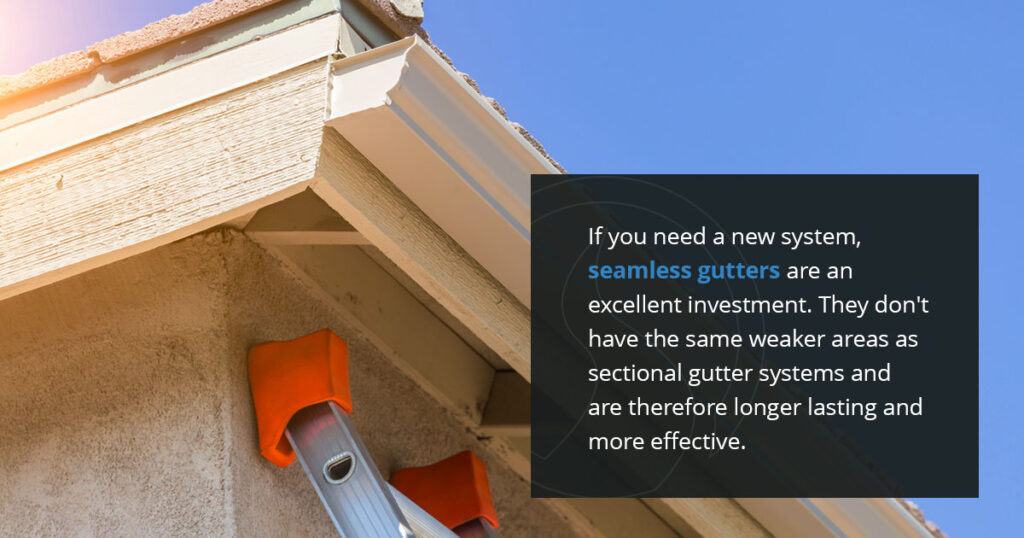
Considering Sectional vs. Seamless Gutters
All gutters come in sectional or seamless constructions. Many gutters are sold in 10- or 15-foot sections that a professional installer will link to line the edges of your roof with snap connectors. The downside to sectional gutters is that the joints can eventually leak or corrode.
In contrast, seamless gutters only have seams at the corners. Seamless gutters are often made of metal and can be cut to custom lengths by professional roofers. When you opt for seamless gutters, professionals will come to your house with machinery that can fold metal sheets to create gutters that fit your home’s exact dimensions.
Seamless gutters tend to be less affordable than sectional gutters and should only be installed by professionals. Sectional gutters come in the above materials and range from $3 to $20 per linear foot. Seamless gutters can be made of aluminum, steel or copper and range from $5 to $40 per linear foot.
When considering the right gutter system for your home, ask yourself whether you’re looking for a new one or hoping to replace an old one with the same system. If you need a new system, seamless gutters are an excellent investment. They don’t have the same weaker areas as sectional gutter systems and are therefore longer lasting and more effective.
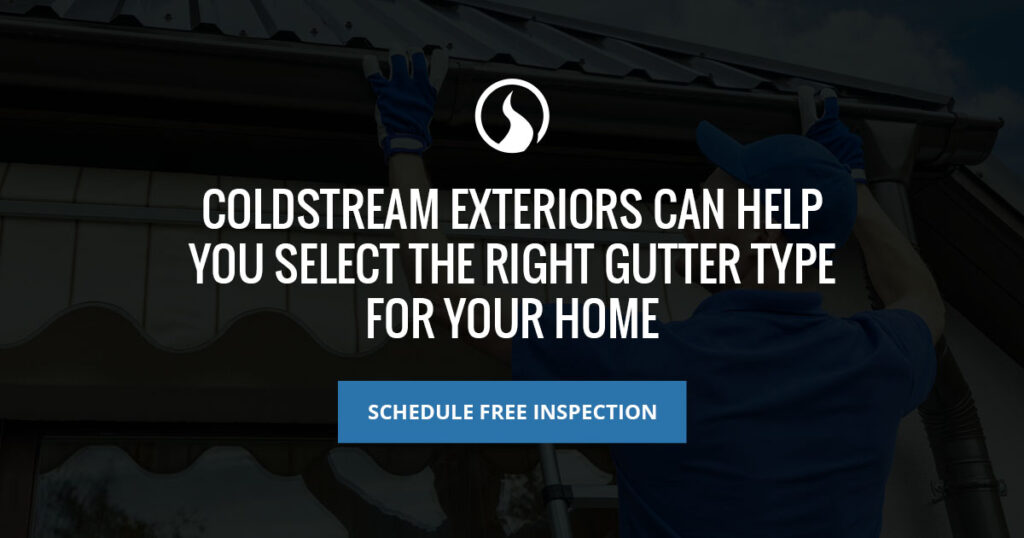
Coldstream Exteriors Can Help You Select the Right Gutter Type for Your Home
When you’re looking for a new high-quality gutter system, always consult with professional roofers to get the job done right. At Coldstream Exteriors, we provide the expertise needed to install gutters correctly and efficiently so you can spend more time on other projects.
We’ll analyze your roof’s pitch and area to assess the right size and style of gutter that best fits your home. We can even help you determine the right materials and add-ons, including the best gutter guards for your home.
To get started on your gutter installation project, schedule a free inspection with us today.
